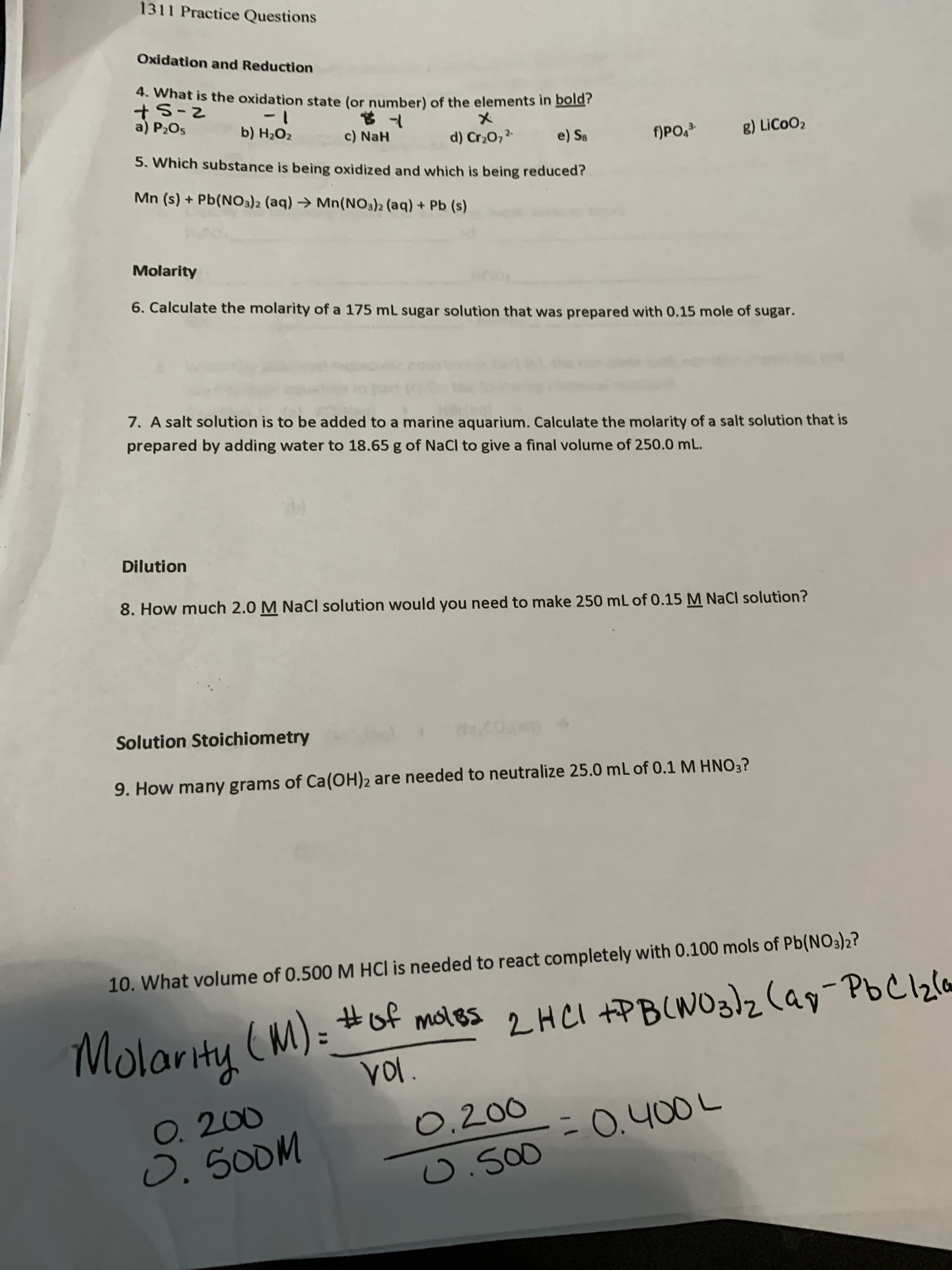1311 Practice Questions Oxidation and Reduction 4. What is the oxidation state (or number) of the elements in bold? a) P2O5 b) H2O2 c) NaH 5. Which substance is being oxidized and which is being reduced? d) Cr20,2 e) Se f)PO, g) LICOO2 Mn (s) + Pb(NO3)2 (aq) → Mn(NO3)2 (aq) + Pb (s) Molarity 6. Calculate the molarity of a 175 mL sugar solution that was prepared with 0.15 mole of sugar. 7. A salt solution is to be added to a marine aquarium. Calculate the molarity of a salt solution that is prepared by adding water to 18.65 g of NaCl to give a final volume of 250.0 mL. Dilution 8. How much 2.0 M NaCI solution would you need to make 250 mL of 0.15 M NaCl solution? Solution Stoichiometry .COA 9. How many grams of Ca(OH)2 are needed to neutralize 25.0 mL of 0.1 M HNO3? 10. What volume of 0.500 M HCl is needed to react completely with 0.100 mols of Pb(NO3)2? #of moles y-PbClzlm -РЬСЕО (M)= VoI. 2HCI +PB(WO3)z(ay Molarity O. 200 O.500M 0,200 =0.400L
1311 Practice Questions Oxidation and Reduction 4. What is the oxidation state (or number) of the elements in bold? a) P2O5 b) H2O2 c) NaH 5. Which substance is being oxidized and which is being reduced? d) Cr20,2 e) Se f)PO, g) LICOO2 Mn (s) + Pb(NO3)2 (aq) → Mn(NO3)2 (aq) + Pb (s) Molarity 6. Calculate the molarity of a 175 mL sugar solution that was prepared with 0.15 mole of sugar. 7. A salt solution is to be added to a marine aquarium. Calculate the molarity of a salt solution that is prepared by adding water to 18.65 g of NaCl to give a final volume of 250.0 mL. Dilution 8. How much 2.0 M NaCI solution would you need to make 250 mL of 0.15 M NaCl solution? Solution Stoichiometry .COA 9. How many grams of Ca(OH)2 are needed to neutralize 25.0 mL of 0.1 M HNO3? 10. What volume of 0.500 M HCl is needed to react completely with 0.100 mols of Pb(NO3)2? #of moles y-PbClzlm -РЬСЕО (M)= VoI. 2HCI +PB(WO3)z(ay Molarity O. 200 O.500M 0,200 =0.400L
Chemical Principles in the Laboratory
11th Edition
ISBN:9781305264434
Author:Emil Slowinski, Wayne C. Wolsey, Robert Rossi
Publisher:Emil Slowinski, Wayne C. Wolsey, Robert Rossi
Chapter12: The Alkaline Earths And The Halongens-two Families In The Periodic Table
Section: Chapter Questions
Problem 2ASA: Substances A2, B2, and C2 can all act as oxidizing agents. In solution, A2 is green, B2 is yellow,...
Related questions
Question
Question 8

Transcribed Image Text:1311 Practice Questions
Oxidation and Reduction
4. What is the oxidation state (or number) of the elements in bold?
a) P2O5
b) H2O2
c) NaH
5. Which substance is being oxidized and which is being reduced?
d) Cr20,2
e) Se
f)PO,
g) LICOO2
Mn (s) + Pb(NO3)2 (aq) → Mn(NO3)2 (aq) + Pb (s)
Molarity
6. Calculate the molarity of a 175 mL sugar solution that was prepared with 0.15 mole of sugar.
7. A salt solution is to be added to a marine aquarium. Calculate the molarity of a salt solution that is
prepared by adding water to 18.65 g of NaCl to give a final volume of 250.0 mL.
Dilution
8. How much 2.0 M NaCI solution would you need to make 250 mL of 0.15 M NaCl solution?
Solution Stoichiometry
.COA
9. How many grams of Ca(OH)2 are needed to neutralize 25.0 mL of 0.1 M HNO3?
10. What volume of 0.500 M HCl is needed to react completely with 0.100 mols of Pb(NO3)2?
#of moles
y-PbClzlm
-РЬСЕО
(M)=
VoI.
2HCI +PB(WO3)z(ay
Molarity
O. 200
O.500M
0,200
=0.400L
Expert Solution
This question has been solved!
Explore an expertly crafted, step-by-step solution for a thorough understanding of key concepts.
This is a popular solution!
Trending now
This is a popular solution!
Step by step
Solved in 2 steps

Knowledge Booster
Learn more about
Need a deep-dive on the concept behind this application? Look no further. Learn more about this topic, chemistry and related others by exploring similar questions and additional content below.Recommended textbooks for you

Chemical Principles in the Laboratory
Chemistry
ISBN:
9781305264434
Author:
Emil Slowinski, Wayne C. Wolsey, Robert Rossi
Publisher:
Brooks Cole

Introductory Chemistry: A Foundation
Chemistry
ISBN:
9781337399425
Author:
Steven S. Zumdahl, Donald J. DeCoste
Publisher:
Cengage Learning

Chemical Principles in the Laboratory
Chemistry
ISBN:
9781305264434
Author:
Emil Slowinski, Wayne C. Wolsey, Robert Rossi
Publisher:
Brooks Cole

Introductory Chemistry: A Foundation
Chemistry
ISBN:
9781337399425
Author:
Steven S. Zumdahl, Donald J. DeCoste
Publisher:
Cengage Learning